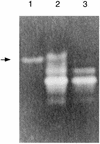Periplasmic superoxide dismutase in meningococcal pathogenicity
- PMID: 9423860
- PMCID: PMC107879
- DOI: 10.1128/IAI.66.1.213-217.1998
Periplasmic superoxide dismutase in meningococcal pathogenicity
Abstract
Meningococcal sodC encodes periplasmic copper- and zinc-cofactored superoxide dismutase (Cu,Zn SOD) which catalyzes the conversion of the superoxide radical anion to hydrogen peroxide, preventing a sequence of reactions leading to production of toxic hydroxyl free radicals. From its periplasmic location, Cu,Zn SOD was inferred to acquire its substrate from outside the bacterial cell and was speculated to play a role in preserving meningococci from the action of microbicidal oxygen free radicals produced in the context of host defense. A sodC mutant was constructed by allelic exchange and was used to investigate the role of Cu,Zn SOD in pathogenicity. Wild-type and mutant meningococci grew at comparable rates and survived equally long in aerobic liquid culture. The mutant showed no increased sensitivity to paraquat, which generates superoxide within the cytosol, but was approximately 1,000-fold more sensitive to the toxicity of superoxide generated in solution by the xanthine/xanthine oxidase system. These data support a role for meningococcal Cu,Zn SOD in protection against exogenous superoxide. In experiments to translate this into a role in pathogenicity, wild-type and mutant organisms were used in an intraperitoneal mouse infection model. The sodC mutant was significantly less virulent. We conclude that periplasmic Cu,Zn SOD contributes to the virulence of Neisseria meningitidis, most likely by reducing the effectiveness of toxic oxygen host defenses.
Figures





References
-
- Beauchamp C O, Fridovich I. Superoxide dismutase: improved assays and an assay applicable to acrylamide gels. Anal Biochem. 1971;44:276–287. - PubMed
-
- Beck B L, Tabatabai L B, Mayfield J E. A protein isolated from Brucella abortus is a Cu-Zn superoxide dismutase. Biochemistry. 1990;29:372–376. - PubMed
-
- Benov L, Chang L Y, Day B, Fridovich I. Copper, zinc superoxide dismutase in Escherichia coli: periplasmic localization. Arch Biochem Biophys. 1995;319:508–511. - PubMed
-
- Benov L T, Fridovich I. Escherichia coli expresses a copper- and zinc-containing superoxide dismutase. J Biol Chem. 1994;269:25310–25314. - PubMed
Publication types
MeSH terms
Substances
Associated data
- Actions
LinkOut - more resources
Full Text Sources
Other Literature Sources
Medical

